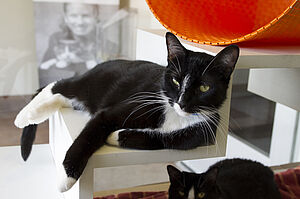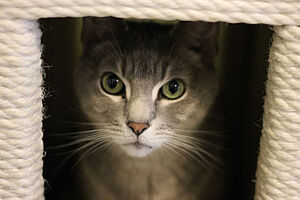Finding Your Cat's Mojo
by Jackson Galaxy | Nov 01, 2014
Acclaimed feline behaviorist, author and star of Animal Planet’s “My Cat From Hell,” Jackson Galaxy, recently visited PAWS Chicago to talk to cat lovers about feline behavior and the crazy things they do to make us love them. In addition to motivating the audience with stories and personal experiences, Galaxy provided tips on how to find homes for harder to place cats, and leveraged tips on how to ‘catify’ a home. Below is an excerpt from his second book, CATIFICATION: Designing a Happy and Stylish Home for Your Cat (and You!) to help you find your cat’s mojo.

What Is Cat Mojo?
What is it that motivates cats? What makes them tick? The answer is confident ownership of territory and the instinctive feeling of having a job to do in that territory. This is cat mojo. When a cat really has his mojo on, he will carry out his daily activities of hunting, catching, killing, and eating his prey, followed by grooming and sleeping, all with confidence. Cat mojo is something all domestic housecats, whom we call family members, inherited from their wildcat ancestors—it’s the Raw Cat in all of them.
Cat mojo is part of who cats are and has a significant impact on how they experience the world. In the Raw Cat’s universe, mojo in action is the key to survival. A confident cat is proactive, while an unconfident cat is reactive. Confident cats have objectives and tasks to complete, while unconfident cats are simply reacting to things happening around them. In short, a mojo-tastic cat is a portrait of confidence in motion.
Cat Archetypes, Mojo Style
Cat mojo is all about ownership. Life on the territorial spectrum encompasses the vast terrain between displays of confident ownership and unconfident posturing and acting out. With the help of Catification, we strive to help all cats be confident and comfortable in owning their environments. To give you some guidelines, consider these three types of cats:
- THE MOJITO CAT (A.K.A. THE HOSTESS WITH THE MOSTEST)
First we have the confident owner of territory, the Mojito Cat. This is the cat that walks into a room, chest held high, tail in the air, with a relaxed posture. She comes right up to you, gives you a little head butt, weaves in and out of your legs, and gives you sweet eyes—she’s a picture of territorial confidence. If that cat was human, and you arrived at her house for a cocktail party, she would greet you at the door with a tray of drinks, saying “Welcome to my house! Help yourself to a mojito. Twist of lime? Come on in and I’ll give you a tour!” The Mojito Cat represents the essence of cat mojoa because she is owning her territory actively, confidently, and in a relaxed way. Her confidence comes from her knowing that everything she has is safely hers.
- THE NAPOLEON CAT (A.K.A. THE OVEROWNER)
Next we have the Napoleon Cat. When you encounter this guy, his ears are forward; he’s glaring at you with eyes zeroed in just a little; and he’s crouching down in an offensive, sometimes even aggressive posture. His initial thought is, Who are you, and what are you here to steal? Perhaps he’s even lying down across the doorway of the house to ensure you’ve got to step over that line. Sometimes the Napoleon Cat pees on things because he doesn’t trust his ownership of the territory—he needs to mark it.
All beings, whether they’re people or animals, who don’t confidently own their territory, overown it instead. Think of gangs who “tag” walls with graffiti—they need to tell competing gangs (and the world at large) that this wall, this block, this neighborhood belongs to them . . . and don’t forget it. The Napoleon Cat is anti-mojo, anti-confidence, because overowning by definition is reactive, not active.
- THE WALLFLOWER CAT (A.K.A. THE DISAPPEARING ACT)
While the overowner is lying across the doorway and the mojito cat is walking around shouting, “Hey! How you doing?”, there remains the cat hanging back against the wall, never walking across the middle of the floor. The Wallflower Cat is saying, “I don’t own this. You must be the owner. Okay, fine, I’m not looking at you, I’m just going to the litter box over there. I’m just leaving. Don’t mind me. Good-bye.” And, just like that, the Wallflower disappears. Like the Napoleon Cat at the other end of the confidence pendulum, the Wallflower Cat is also anti-mojo because hiding is reactive, not active. It doesn’t matter whether or not the threat is real or imagined—it still deserves her full attention and prompt action.
We want all cats to be their version of mojito cats; in other words, not conforming to what we think confidence should look like but acknowledging their tendencies and easing their anxieties to make them the best Mojito Cat they can be. If your cat is a Wallflower, you’ve got to bring them out a little bit. If they’re an overowner, you’ve got to pull them back a little bit. Why? Because we want all cats to own their territory with confidence—and we believe it’s a completely attainable goal.
The Confident Where

Catification is all about creating an environment where your cat is confident and comfortable. Cats assess territory in its entirety; that is to say, they see the entire world, both horizontal and vertical, as space worthy of ownership. Even if your cat is a Napoleon Cat or a Wallflower Cat, you can be sure he finds confidence someplace.
When your cat walks into a room, where is he most confident? Remember, it’s all about cat mojo, that inner sense of having a job to do, and, of equal importance, knowing where he does that job best. So if your cat is expressing confidence in his environment, he will be actively surveying the “confident where” of the territory. Somewhere from floor to ceiling you will find him stalking his prey, grooming, or resting. Remember, hiding or becoming small does not signify confidence. The key to confidence is spotting proactivity as opposed to reactivity.
We’ve broken the confident where into three basic places. When a cat expresses his mojo in one of these places, we call it dwelling. Dwelling equals owning with confidence, and that’s exactly what you want to see your cat doing. Let’s take a look at the three types of dwellers.
- THE BUSH DWELLER
A Bush Dweller is a cat who is confident in spots that are down low and somewhat hidden from view, like under a table or behind a potted plant. From this spot, he can survey his territory, stalk his prey, or simply rest with ease. Think about cats in the wild, hanging out in the bush. They’re waiting to hunt, to strike, to pounce. They’re down there getting their mojo on. One thing they are not doing is hiding; even while hidden, even while perfectly still, the mojorific cat is still engaged.
- THE TREE DWELLER
The Tree Dweller isn’t on the ground; he’s up somewhere in the vertical world. Think about leopards taking their kill up into a tree. Why? Not to hide from everybody but to demonstrate confidence. He’s saying “I feel safe up here. My kill is safe from the other cats down on the ground. And I want the cats on the ground to see what I’ve done.”
Here’s the important thing about tree dwelling: it can be anywhere above the ground. Tree dwelling doesn’t necessarily mean way up in the rafters. Rafters are included, for sure, but it can also in- clude a chair, a table, or the top of the couch. The key is demonstrating confidence anywhere in the vertical world.
- THE BEACH DWELLER
Like the Bush Dweller, the Beach Dweller is also down on the floor, with all four paws planted firmly on the ground; however, Beach Dwellers like being out. This is the cat you trip over every day when you walk into the living room. Just like the leopard eating its prey in the tree, this cat is making a territorial play. Beach dwellers are sending a clear message to you and the other animals in the house that the center of the floor is their territory. They’re saying, “If you want to walk through this room, you’re going to have to go around me.”
The Unconfident Where

THE ANTI-DWELLER
If your cat is under the bed, making himself small and invisible, or cowering on top of the refrigerator, this is not expressing confidence. This is not dwelling. Rather, this is exhibiting fear; it is anti-dwelling. Unconfident cats are in a place of hiding because there’s nowhere else for them to be. They’re trying to disappear or get away. Here are some antidwelling behaviors to look out for:
CAVING - Caving is a term for cats that are hiding away out of fear. They are trying to do nothing but vanish. When a cat is caving, he is trying to disappear into a dark, enclosed space where no one can find him. We can allow cats to be tucked away in secluded areas, but we need to control where these places are.
FRIDGING - This a cat who hides on top of the fridge, or in another place that’s up high, to get away from other cats or people in the house who are tormenting him (it doesn’t matter whether the torment is real or perceived.) He’s not coming down because he only feels safe up where he can disappear. It becomes our very important job as guardians to show him that safety does not equal confidence.
CATIFY
Of course you want to help your cat transition from caving to bush dwelling, and from fridging to tree dwelling. How do you do that? First and foremost, you Catify. You allow the territory to become his ally. You add features that allow your cat to move around with confidence first in his “comfort zones,” and then, over time, encourage him to come out and join the rest of the world. If your cat is displaying the unconfident—fear and the urge to disappear and be small—it’s your job to gently push his challenge line, demonstrating to him that he can, with relative ease, move from that place of fear into a confident world that is set up for him step into his greatness.
